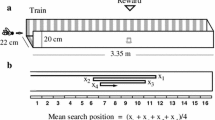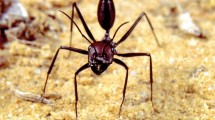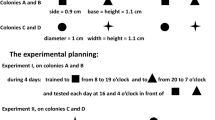Abstract
In contrast to flying insects, in which distance estimation is visually mediated, self-induced image motion and use of familiar landmarks are known to play a minor role in ants. Here we show that strictly diurnal Cataglyphis cursor ants can gauge with accuracy the distance they have travelled even in complete darkness in the absence of any other cues, i.e. chemical or protocounting information. Thus, an ant’s odometer is a vision-independent system based on proprioceptive cues, implicating some form of step counting, which remain to be elucidated.


Similar content being viewed by others
References
Bhatkar A, Whitcomb WH (1970) Artificial diet for rearing various species of ants. Fla Entomol 53:229–232
Chittka L, Geiger K (1995) Can honeybees count landmarks? Anim Behav 49:159–164
Chittka L, Williams NM, Rasmussen H, Thomson JD (1999) Navigation without vision/bumblebee orientation in complete darkness. Proc R Soc Lond B 266:45–50
Durier V, Rivault C (1999) Path integration in cockroach larvae, Blattella germanica (L.) (insect: Dictyoptera): Direction and distance estimation. Anim Learn Behav 27:108–118
Esch HE, Burns JE (1995) Honeybees use optic flow to measure the distance of a food source. Naturwissenschaften 82:38–40
Heusser D, Wehner R (2002) The visual centring response in desert ants, Cataglyphis fortis. J Exp Biol 205:585–590
Hrncir M, Jarau S, Zucchi R, Barth FG (2003) A stingless bee (Melipona seminigra) uses optic flow to estimate flight distances. J Comp Physiol A 189:761–768
Layne JE, Barnes WJP, Duncan LMJ (2003) Mechanisms of homing in the fiddler crab Uca rapax. 2. Information sources and frame of reference for a path integration system. J Exp Biol 206:4425–4442
Lenoir A, Nowbahari E, Querard L, Pondicq N, Delalande C (1990) Habitat exploitation and intercolonial relationships in the ant Cataglyphis cursor. Acta Oecol 11:3–18
Pastergue I, Beugnon G, Lachaud JP (1995) Ants Cataglyphis cursor encode landmarks-landmarks relationships in addition to landmarks-goal relationships. J Insect Behav 8:115–132
Piéron H (1904) Du rôle du sens musculaire dans l’orientation des fourmis. Bull Inst Gen Psychol 4:168–186
Piéron H (1912) Le problème de l’orientation envisagé chez les fourmis. Scientia 12:217–243
Rivault C, Durier V (2004) Homing in German cockroaches, Blattella germanica (L.) (Insecta: Dictyoptera): multi-channelled orientation cues. Ethology 110:761–777
Ronacher B, Wehner R (1995) Desert ants Cataglyphis fortis use self-induced optic flow to measure distances travelled. J Comp Physiol A 177:21–27
Ronacher B, Gallizzi K, Wohlgemuth S, Wehner R (2000) Lateral optic flow does not influence distance estimation in the desert ant Cataglyphis fortis. J Exp Biol 203:1113–1121
Sommer S, Wehner R (2004) The ant’s estimation of distance travelled: experiments with desert ants, Cataglyphis fortis. J Comp Physiol A 190:1–6
Srinivasan MV, Zhang SW, Lehrer M, Collett TS (1996) Honeybee navigation en route to the goal: Visual flight control and odometry. J Exp Biol 199:237–244
Srinivasan MV, Zhang SW, Altwein M, Tautz J (2000) Honeybee navigation: nature and calibration of the odometer. Science 287:851–853
Thiélin-Bescond M (2003) Etude préliminaire du rôle de la distance dans l’apprentissage de routes chez la fourmi Cataglyphis cursor. DESU. Université Paul-Sabatier, Toulouse
Wehner R, Srinivasan MV (1981) Searching behaviour of desert ants, genus Cataglyphis (Formicidae, Hymenoptera). J Comp Physiol A 142:315–338
Wohlgemuth S, Ronacher B, Wehner R (2001) Ant odometry in the third dimension. Nature 411:795–798
Wohlgemuth S, Ronacher B, Wehner R (2002) Distance estimation in the third dimension in desert ants. J Comp Physiol A 188:273–281
Zollikofer CPE (1994) Stepping patterns in ants. I. Influence of speed and curvature. J Exp Biol 192:95–106
Acknowledgements
Thanks are due to three anonymous referees for comments and corrections. We thank Eric Le Bourg and Martin Giurfa for their helpful comments on an earlier version of the article and to Gérard Latil for laboratory breeding of Cataglyphis cursor ants and helping with the experimental set up.
Author information
Authors and Affiliations
Corresponding author
Rights and permissions
About this article
Cite this article
Thiélin-Bescond, M., Beugnon, G. Vision-independent odometry in the ant Cataglyphis cursor. Naturwissenschaften 92, 193–197 (2005). https://doi.org/10.1007/s00114-005-0609-1
Received:
Accepted:
Published:
Issue Date:
DOI: https://doi.org/10.1007/s00114-005-0609-1




